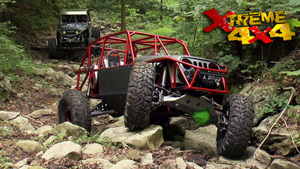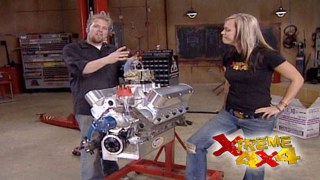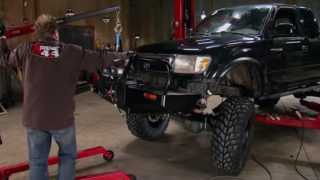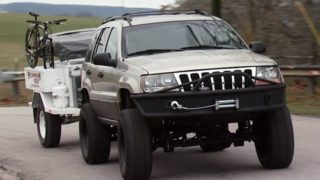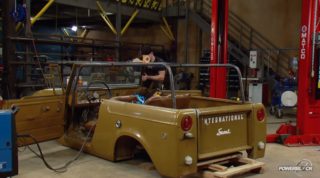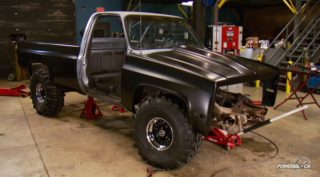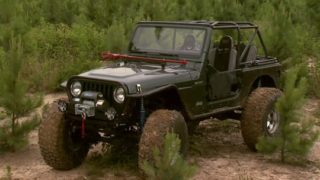More Trophy Truck Episodes
Xtreme 4x4 Builds
Want more content like this?
Join the PowerNation Email NewsletterParts Used In This Episode
ARP
Head Fasteners
Comp Cams
Camshaft with a .266 intake, .272 exhaust duration and a .726 lift.
CP Pistons
Pistons with a 4.15" bore, 6.5cc dome, and 1.25 compression height.
Dart
Pro 1 CNC Machined Cylinder Heads with a 62cc combustion chamber, 2.08" intake valve allowing to flow 325cc per minute and a and a 1.60" exhaust valve pushing 235cc on the exhaust side.
Dart
This Iron Eagle 434ci Ford Small Bock is based on a Ford 351 Windsor and is made with a suoerior iron alloy and has a 9.5" deck height, 0.5" blind cylinder bolt holes, and splayed (angled) bolts.
Eagle Specialty Products
351 Crankshaft with a 4" stroke and 6.25" long 4340 H-beam connecting rods with a full floating piston pin measuring .972" across.
Edelbrock
Super Victor Jr. 351 Aluminum Manifold is designed for large displacement engines with high RPM. The larger intake runners allow more fuel and air to be atomized before entering the cylinder and the gap between the runners keep that mixture cooler for more power.
Fel-Pro Gaskets
Performance Series Gaskets
Jesel Inc.
Adjustable Belt Drive Timing Set and Roller Rocker Arms.
MAHLE Aftermarket
Clevite 77 engine bearings utilize a superior TriMetal™ design producing a degree of conformability, embedability, slipperiness and fatigue resistance.
Moroso
External dry sump oil system with the filtered fittings, remote reservoir and a 5 stage oil pump with brackets and pulleys. Plus an electric Water Pump.
MSD Ignition
Pro-Billet Distributor, MSD6 Off-Road Ignition Control Box, Rev Control, HVC Coil, and Ignition Wires
Olson Motorsports
Dual kickout drysump oil pan made out of .090" aluminum with .250" billet rails
PC Performance
Carburetor and Spacer Plate.
Royal Purple
Max-Tuff assembly lube is an ultra-tough, synthetic lubricant designed for use in reassembling repaired equipment.
Speed-o-Motive
Engine builders that machined, balanced, and fit the block components.
Summit Racing
Aluminum Valve Covers
Total Seal
Piston Rings - 2 compression and 1 low tension oil ring.
Episode Transcript
Today on Xtreme 4x4,
there are 800 horse monsters tearing up tracks today. Find out what's under the hood of these beasts. When our team assembles their pro two race motor plus quad meets trophy truck in the latest off road craze U TV. Cross.
Welcome to Xtreme 4x4. You know, it's often referred to as the heart of the beast. And when you're talking hard core race engines, like for our core pro two truck,
an engine is more than just a power plant. It's a technological marvel building tons of horsepower and God's a torque. The average core engine floats around 800 horsepower and the rural state that it can be no larger than
466 ID.
But since this truck is going to be traveling around on the trade show circuit, we chose a slightly de T
version of 434 C.
Now,
this is the first all out race engine we've ever built here at extreme. So we're going to take you through it, step by step. But the cool thing is a lot of the tips and tricks about putting together a race motor applied to building a regular street motor
for our
engine. We knew we needed some information from some people in the know. So we called up Speedo Motive for over 60 years. These guys have been leaders in innovative Stroker engine combinations
and they are one of the first engine builders to build short course specific race motors designed to deliver the maximum horsepower on realistic budget.
Now for a good engine, we're going to need a great block. So we chose a dart iron eagle cast iron block based on a 351 Windsor. Now it's made of a superior iron alloy and this one has a 9.5 inch deck height and half inch blind cylinder bolt holes. So you don't have to worry about coolant
up the threads of your head fasteners. But the real news is actually down in the main bearing caps. Number 23 and four have what's called splayed bolts, bolts on an angle. Now that helps strengthen up the bottom end of this motor because once they're installed and torque down, it basically wedges that cap right into place.
The Slade bolts provide clamping forces into the block to help contain the side loading of the caps during the crank shaft rotation.
The main journals measure 2.750 inches.
And for this engine, we're going to use Clevite's 77 bearings with a light coating of Royal purple assembly loop.
Then the eagle 351 crank with a four inch stroke is dropped into the block and the main caps are torn,
the half inch bolts to 100 and 5 ft pounds.
The 716 displayed bolts go to 65 and the 3/8 bolts on either end are torque to 35 ft pounds
inside our short block. We're going to be installing some pretty trick parts. Now, the crank shaft along with the rest of the rotating assembly was all balanced by the guys over at speed Emotive.
And the first thing, the bolt on of that crank shaft will obviously be a set of connecting rods. These are eagle 4340 H beam connecting rods. They're 6.25 inches in length and the full floating piston pin measures 0.9 to seven inches across on top of this connecting rod. Obviously, they're going to go the pistons for those we got from CP.
They are a piston spec for this motor. It's 4.15 inches and bore 6.5 CC dome and a 1.25 inch compression height. Obviously on the piston, we're gonna need some rings. We got total seal rings for this motor, two compression rings and one low tension oil ring. Now, obviously, all of these parts are super strong and it's what you want in a full on race motor. This is not a street and strip motor
but the cool thing is that the technology that's in here, not only do we get strength, we'll actually get more power. You just need to know how
the lightweight pistons allow the engine to reach higher RPM. S without the fear of damage. When this engine is spinning at say 6000 RPM,
the piston is traveling from the top of the cylinder to the bottom stopping
and then returning to top dead center 100 times per second.
The stronger rods and crank shafts help hold the assembly together.
This strength is needed to provide reliability during the race
but the extra horsepower is with the rings.
The total seal rings operate without a gap once installed.
This allows the rings to have less tension on the cylinder walls without losing compression.
This will actually build more power in the engine because of less friction
for the
C
we chose
AC C
with the 266 intake and a 272 exhaust duration
and the 726 left.
Now all of this has to do with building power inside your engine.
But what does valve lift duration and valve overlap really have to do with power? Well, let's go to the ch
board
to understand how the cam shaft builds more power in the engine. We have to go right back to basics, back to the four stroke.
Now, the first stroke is the intake stroke where the piston is traveling down the cylinder with the intake valve open. This causes a low pressure area inside the cylinder which draws air and fuel past the carburetor into the cylinder itself. Now, the second stroke is the compression stroke, both valves then close, the piston travels back up the cylinder compressing all the fuel and air that was in the cylinder up into the combustion chamber itself.
And the third stroke is the power stroke.
That's where the spark plug ignites. Both valves are closed. All the fuel and air compressed in the combustion chamber burns and expands since there's nowhere for that expanding gas to go, it forces the piston down and causes the crank shaft to turn.
The last stroke is the exhaust stroke. Basically, the piston traveling back up the cylinder, the exhaust valve open sends all the burnt fuel and air
into the exhaust system.
Now to make more power and engine, we have to make it more efficient, burn more fuel and air and get more fuel and air out. We do that in three different ways. First is with valve lift. If a stock engine only allows the valve to open and close so far with an aftermarket camshaft, we're going to increase that lift and open the valve further. Therefore letting more fuel and air in and more exhaust out. Now, there is a limit as to how much valve lift we can add before the valve itself will actually start to contact the piston.
Now, the second is duration and that's the length of time that that valve is open. Now, we have a limitation here because we don't want the valves open too far at which point they're open together and therefore the engine becomes inefficient.
And the third one is with valve overlap as the exhaust valve starts to close and the
burnt fuel and air is exiting into the exhaust, we'll go ahead and open the intake valve a little bit sooner.
That will cause the scavenging effect of the exhaust system that's drawing all that burnt fuel and air out will actually help pull more new fuel and air into the cylinder to help it burn and therefore make more power. So a camshaft itself can make a huge difference in pretty much any motor and all we have to do now is put ours in our engine and we'll be ready with the top end
coming up. Who says desert racing is a rich man's game. These drivers are doing it in a Rhino U TV cross when Xtreme 4x4 continues.
Welcome back to Xtreme 4x4 where it is still the shop putting together our 434 CIC
inch engine
that will eventually go to our core Pro two truck.
And I know
you guys are thinking man, I would love to start racing
for,
but I just don't have a half a million dollars in my pocket. Well, no worries because there's a new form of racing that pretty much everyone can afford
motorcycle racing to the exercise. Boom. What blows up in southern California becomes huge across the nation.
The latest craze in Cali is called U TV. Cross.
Exciting to a
blast. Like being a kid again. It's pretty darn fun. When Yamaha introduced the Rhino utility vehicle, they never envisioned this.
The hunters would use them for gun racks on them and all their stuff so they could go out and get in the rough train back there. It was all over. People start modifying them. The next thing you know, we're racing
now. They're a long way from hunting moose. It's
a
cross between
a and a
trophy truck competing on local motocross tracks.
The drivers of the mod and stock classes have to endure 15 brutal laps.
You can get to hell, get out there and push these things to the limit
and you're going to get hardcore known around the world as the godfather of freestyle Motocross.
Mike Med,
give this series his blessing. Rno racing. Great off road, good racing
over the past year. Word about this series has spread quicker than the California wildfire. We're one of the first four cars to race every weekend.
Now we're showing up and there's 25 modified Rhinos out here racing. Tell you what it's booming right now. It's, it's tremendously huge. A lifelong racer, Todd Arthur is all about going huge. You know, I've had a lot of off road experience in the
are racing and we had a Rhino that we used for a pit cart. We thought what the heck we'd come out and try it and I'll tell you, I haven't done much desert racing, but I should have done a lot of Rhino racing dominating the mod class points. Todd wasn't monkeying around when he built the flying banana. Basically started out as a Rhino. You can buy one for about $10,000 and then from there, depending on how far you want to go with it, you can dump about another 20 $25,000.
We're about $35,000 into this racing on tracks littered with double and triple jumps. The suspension was priority one. Obviously, we have extended the suspension and added some coil over shock, some fox shocks and that really helps us out over the jumps. We're able to achieve about 18 inches of rear wheel travel in about 17 inches of front wheel travel and we're still using the existing four wheel drive out of the thing
didn't settle for the 30 horses that comes with a Rhino. We have a modified Rhino 660 motor in it, which is a 686 right now
with some little head parting and carburetor modifications to do things like that. We probably achieved about an extra 15 horsepower out of it. Leaving behind hundreds of horses in desert racing.
Todd Arthur has no regrets. I got to tell you it's probably the most fun I've had
running stock suspension and shocks. Some folks prefer their racing old school style.
I like stock.
The stock guys were a tougher breed for stock points leader, Jimmy White. So
this class is about being a tough guy. There's not on how much money you got. It's all about skill in a sport that welcomes newcomers. Jimmy's wife.
It
came out last time he raised
and one and watch him and
told him I wanted to race to,
went out and got me right now.
And
that didn't mean she take it easy on her. Ho
if I get a shot that
Jimmy had no need to worry as he blew away the field while
ended up in last place.
Thought I'd do a little bit better, but
I'll get the hang of it. Hopefully I'll get better and get right up there with my husband. It doesn't matter where she finishes to Jimmy, she'll always be his champion. Oh, I'm very proud of her to come out here and to take initiative to want to race with the guys. So I'm very proud of her. She, she did really good.
See
girls who says we can't race even though she came in last place. She's still trying. That means you can do
by yourself.
Ya ha.
Right.
Easy.
Welcome back to Xtreme 4x4 where we're right in the middle of putting together this monster 434 cubic inch Ford small block that we're gonna be putting in our core pro two race truck. Now, so far we have the entire rotating assembly installed in the block, the camshaft is in and I'm just finishing up the front end with this Jessel belt drive system. Now, Jessel is the originator of the belt drive. And when it comes to race motors, they're great to have for a couple of different reasons. Number one, you can
go ahead and advance or retire the cam timing right at the front cover without disassembling the engine. Number two, you can do what's called a hot swap on the camshaft. You can simply pull the camshaft out of the motor without removing this front cover or the oil pan. Therefore, it's easier to do in the pits. And with this piece on the short block is basically complete, we can go ahead and start thinking about the oiling system.
Now, when you're talking about a race motor, you're obviously gonna be talking about a dry sump oil system.
That means that all the oil for this motor is gonna be kept in this storage tank that's kept away from the engine and therefore cooler. But it's also gonna allow us to build more power in this motor once again,
simply because all the oil isn't gonna be sitting inside the crank case for the crank shaft to have to cut through it. Actually robs power from the motor when that has to happen.
Also, the dry sump system creates a vacuum inside the crank case which helps suck more fuel and air into the combustion chamber. Therefore, more power,
you do need a specific pan for this type of application
and for our core engine, it's for Olsen motor sports.
Now, this dual kick out pan is made from 0 90 aluminum with quarter inch billet rails and a unique capturing trough for the best oil scavenging.
A dry sump oil system obviously needs an externally mounted oil pump. And ours is a five stage unit from Moroso. So basically five oil pumps stacked in a row
and it's driven off a cog belt from the crank shaft and the pressure is controlled by the last stage itself. This will scavenge all the oil from our oil pan as well as from the cylinder head bleed down areas on the block.
It will then deliver pressurized oil to five different areas of the engine to keep it lubricated. Now, one good idea when you're putting on a dry sump kit is to make sure to use a screened fitting on the inlet side. That way, if anything ever happens to the motor engine, debris won't end up getting into the oil pump and therefore ruining it. Now, this just mounts off the side of the block and it mounts hand in hand with our num Moroso electric water pump.
Now, if the camshaft is responsible for building big power in the short block, the cylinder heads are responsible for the power gains on top of the engine. Now, these are Dart Pro one CNC aluminum heads. They have a 62 cc combustion chamber, 2.08 inch intake valve
and a 1.6 exhaust.
They flow 325 cubic feet per minute through the intake and 235 cubic feet through the exhaust.
Basically, the lightweight of these heads is going to make our engine lighter and the design is going to help our small block build, big power
sealing these heads and the rest of our engine will be Fel pro performance series gaskets and a RP fasteners
to control the valves. We'll be using roller rockers also from Jessel covered with fabricated aluminum valve covers from summit racing.
Welcome back to the extreme shop where Jessi and Ian are buttoning up the top end of their 434 cubic inch race motor
and
we're going to be using MS D components from start to finish.
The pro
distributor will turn our R elector assembly with the hard and still shaft for high RPM and a long life of abuse.
The MS D six off road ignition control box will give us a multiple spark discharge for a 20 degree crank shaft rotation
will also be installing a R control
HP C coil and the
ignition wires to round out the whole package.
Now to finish off the top end of our motor, we're using an Edelbrock Super Victor Junior 351 aluminum manifold PC performance carburetor and spacer combination Now, the Super Victor manifold is designed for large displacement high RPM engines, so it'll work great on our 434 Stroker. Now, the larger intake runner design allows for more fuel and air to be atomized before it enters the cylinder and the air gap allows that fuel and air to stay cooler for more power. Now, the
C carburetor starts life as a Ha Haley 4150 unit, it's completely disassembled, blueprinted, a high flow needle and seat are installed and all the venturia are polished, then everything is safety wired together. And this off road slosh tube is installed to keep fuel from spilling out of the vents and falling into the carburetor itself and therefore flooding out the motor. Now, this combination is good for up to 950 horsepower. So it should feed our motor, no problem at all.
Well, there you have it guys, a complete one of the kind race engine for a pro two truck. But before it probably gets dropped in, we're going to take you down to the horsepower guys and use their engine dyno
to see what kind of numbers we pull up the fly.
Well,
but obviously we have a few things to do before then like the dry sump oil lines have to do some kind of air cleaner assembly and then some headers, but we promise we won't pull any girl poles until you guys are back here with us at extreme so you can see the numbers with us
right with us.
I bet. 692.
702,
693.
Show Full Transcript
there are 800 horse monsters tearing up tracks today. Find out what's under the hood of these beasts. When our team assembles their pro two race motor plus quad meets trophy truck in the latest off road craze U TV. Cross.
Welcome to Xtreme 4x4. You know, it's often referred to as the heart of the beast. And when you're talking hard core race engines, like for our core pro two truck,
an engine is more than just a power plant. It's a technological marvel building tons of horsepower and God's a torque. The average core engine floats around 800 horsepower and the rural state that it can be no larger than
466 ID.
But since this truck is going to be traveling around on the trade show circuit, we chose a slightly de T
version of 434 C.
Now,
this is the first all out race engine we've ever built here at extreme. So we're going to take you through it, step by step. But the cool thing is a lot of the tips and tricks about putting together a race motor applied to building a regular street motor
for our
engine. We knew we needed some information from some people in the know. So we called up Speedo Motive for over 60 years. These guys have been leaders in innovative Stroker engine combinations
and they are one of the first engine builders to build short course specific race motors designed to deliver the maximum horsepower on realistic budget.
Now for a good engine, we're going to need a great block. So we chose a dart iron eagle cast iron block based on a 351 Windsor. Now it's made of a superior iron alloy and this one has a 9.5 inch deck height and half inch blind cylinder bolt holes. So you don't have to worry about coolant
up the threads of your head fasteners. But the real news is actually down in the main bearing caps. Number 23 and four have what's called splayed bolts, bolts on an angle. Now that helps strengthen up the bottom end of this motor because once they're installed and torque down, it basically wedges that cap right into place.
The Slade bolts provide clamping forces into the block to help contain the side loading of the caps during the crank shaft rotation.
The main journals measure 2.750 inches.
And for this engine, we're going to use Clevite's 77 bearings with a light coating of Royal purple assembly loop.
Then the eagle 351 crank with a four inch stroke is dropped into the block and the main caps are torn,
the half inch bolts to 100 and 5 ft pounds.
The 716 displayed bolts go to 65 and the 3/8 bolts on either end are torque to 35 ft pounds
inside our short block. We're going to be installing some pretty trick parts. Now, the crank shaft along with the rest of the rotating assembly was all balanced by the guys over at speed Emotive.
And the first thing, the bolt on of that crank shaft will obviously be a set of connecting rods. These are eagle 4340 H beam connecting rods. They're 6.25 inches in length and the full floating piston pin measures 0.9 to seven inches across on top of this connecting rod. Obviously, they're going to go the pistons for those we got from CP.
They are a piston spec for this motor. It's 4.15 inches and bore 6.5 CC dome and a 1.25 inch compression height. Obviously on the piston, we're gonna need some rings. We got total seal rings for this motor, two compression rings and one low tension oil ring. Now, obviously, all of these parts are super strong and it's what you want in a full on race motor. This is not a street and strip motor
but the cool thing is that the technology that's in here, not only do we get strength, we'll actually get more power. You just need to know how
the lightweight pistons allow the engine to reach higher RPM. S without the fear of damage. When this engine is spinning at say 6000 RPM,
the piston is traveling from the top of the cylinder to the bottom stopping
and then returning to top dead center 100 times per second.
The stronger rods and crank shafts help hold the assembly together.
This strength is needed to provide reliability during the race
but the extra horsepower is with the rings.
The total seal rings operate without a gap once installed.
This allows the rings to have less tension on the cylinder walls without losing compression.
This will actually build more power in the engine because of less friction
for the
C
we chose
AC C
with the 266 intake and a 272 exhaust duration
and the 726 left.
Now all of this has to do with building power inside your engine.
But what does valve lift duration and valve overlap really have to do with power? Well, let's go to the ch
board
to understand how the cam shaft builds more power in the engine. We have to go right back to basics, back to the four stroke.
Now, the first stroke is the intake stroke where the piston is traveling down the cylinder with the intake valve open. This causes a low pressure area inside the cylinder which draws air and fuel past the carburetor into the cylinder itself. Now, the second stroke is the compression stroke, both valves then close, the piston travels back up the cylinder compressing all the fuel and air that was in the cylinder up into the combustion chamber itself.
And the third stroke is the power stroke.
That's where the spark plug ignites. Both valves are closed. All the fuel and air compressed in the combustion chamber burns and expands since there's nowhere for that expanding gas to go, it forces the piston down and causes the crank shaft to turn.
The last stroke is the exhaust stroke. Basically, the piston traveling back up the cylinder, the exhaust valve open sends all the burnt fuel and air
into the exhaust system.
Now to make more power and engine, we have to make it more efficient, burn more fuel and air and get more fuel and air out. We do that in three different ways. First is with valve lift. If a stock engine only allows the valve to open and close so far with an aftermarket camshaft, we're going to increase that lift and open the valve further. Therefore letting more fuel and air in and more exhaust out. Now, there is a limit as to how much valve lift we can add before the valve itself will actually start to contact the piston.
Now, the second is duration and that's the length of time that that valve is open. Now, we have a limitation here because we don't want the valves open too far at which point they're open together and therefore the engine becomes inefficient.
And the third one is with valve overlap as the exhaust valve starts to close and the
burnt fuel and air is exiting into the exhaust, we'll go ahead and open the intake valve a little bit sooner.
That will cause the scavenging effect of the exhaust system that's drawing all that burnt fuel and air out will actually help pull more new fuel and air into the cylinder to help it burn and therefore make more power. So a camshaft itself can make a huge difference in pretty much any motor and all we have to do now is put ours in our engine and we'll be ready with the top end
coming up. Who says desert racing is a rich man's game. These drivers are doing it in a Rhino U TV cross when Xtreme 4x4 continues.
Welcome back to Xtreme 4x4 where it is still the shop putting together our 434 CIC
inch engine
that will eventually go to our core Pro two truck.
And I know
you guys are thinking man, I would love to start racing
for,
but I just don't have a half a million dollars in my pocket. Well, no worries because there's a new form of racing that pretty much everyone can afford
motorcycle racing to the exercise. Boom. What blows up in southern California becomes huge across the nation.
The latest craze in Cali is called U TV. Cross.
Exciting to a
blast. Like being a kid again. It's pretty darn fun. When Yamaha introduced the Rhino utility vehicle, they never envisioned this.
The hunters would use them for gun racks on them and all their stuff so they could go out and get in the rough train back there. It was all over. People start modifying them. The next thing you know, we're racing
now. They're a long way from hunting moose. It's
a
cross between
a and a
trophy truck competing on local motocross tracks.
The drivers of the mod and stock classes have to endure 15 brutal laps.
You can get to hell, get out there and push these things to the limit
and you're going to get hardcore known around the world as the godfather of freestyle Motocross.
Mike Med,
give this series his blessing. Rno racing. Great off road, good racing
over the past year. Word about this series has spread quicker than the California wildfire. We're one of the first four cars to race every weekend.
Now we're showing up and there's 25 modified Rhinos out here racing. Tell you what it's booming right now. It's, it's tremendously huge. A lifelong racer, Todd Arthur is all about going huge. You know, I've had a lot of off road experience in the
are racing and we had a Rhino that we used for a pit cart. We thought what the heck we'd come out and try it and I'll tell you, I haven't done much desert racing, but I should have done a lot of Rhino racing dominating the mod class points. Todd wasn't monkeying around when he built the flying banana. Basically started out as a Rhino. You can buy one for about $10,000 and then from there, depending on how far you want to go with it, you can dump about another 20 $25,000.
We're about $35,000 into this racing on tracks littered with double and triple jumps. The suspension was priority one. Obviously, we have extended the suspension and added some coil over shock, some fox shocks and that really helps us out over the jumps. We're able to achieve about 18 inches of rear wheel travel in about 17 inches of front wheel travel and we're still using the existing four wheel drive out of the thing
didn't settle for the 30 horses that comes with a Rhino. We have a modified Rhino 660 motor in it, which is a 686 right now
with some little head parting and carburetor modifications to do things like that. We probably achieved about an extra 15 horsepower out of it. Leaving behind hundreds of horses in desert racing.
Todd Arthur has no regrets. I got to tell you it's probably the most fun I've had
running stock suspension and shocks. Some folks prefer their racing old school style.
I like stock.
The stock guys were a tougher breed for stock points leader, Jimmy White. So
this class is about being a tough guy. There's not on how much money you got. It's all about skill in a sport that welcomes newcomers. Jimmy's wife.
It
came out last time he raised
and one and watch him and
told him I wanted to race to,
went out and got me right now.
And
that didn't mean she take it easy on her. Ho
if I get a shot that
Jimmy had no need to worry as he blew away the field while
ended up in last place.
Thought I'd do a little bit better, but
I'll get the hang of it. Hopefully I'll get better and get right up there with my husband. It doesn't matter where she finishes to Jimmy, she'll always be his champion. Oh, I'm very proud of her to come out here and to take initiative to want to race with the guys. So I'm very proud of her. She, she did really good.
See
girls who says we can't race even though she came in last place. She's still trying. That means you can do
by yourself.
Ya ha.
Right.
Easy.
Welcome back to Xtreme 4x4 where we're right in the middle of putting together this monster 434 cubic inch Ford small block that we're gonna be putting in our core pro two race truck. Now, so far we have the entire rotating assembly installed in the block, the camshaft is in and I'm just finishing up the front end with this Jessel belt drive system. Now, Jessel is the originator of the belt drive. And when it comes to race motors, they're great to have for a couple of different reasons. Number one, you can
go ahead and advance or retire the cam timing right at the front cover without disassembling the engine. Number two, you can do what's called a hot swap on the camshaft. You can simply pull the camshaft out of the motor without removing this front cover or the oil pan. Therefore, it's easier to do in the pits. And with this piece on the short block is basically complete, we can go ahead and start thinking about the oiling system.
Now, when you're talking about a race motor, you're obviously gonna be talking about a dry sump oil system.
That means that all the oil for this motor is gonna be kept in this storage tank that's kept away from the engine and therefore cooler. But it's also gonna allow us to build more power in this motor once again,
simply because all the oil isn't gonna be sitting inside the crank case for the crank shaft to have to cut through it. Actually robs power from the motor when that has to happen.
Also, the dry sump system creates a vacuum inside the crank case which helps suck more fuel and air into the combustion chamber. Therefore, more power,
you do need a specific pan for this type of application
and for our core engine, it's for Olsen motor sports.
Now, this dual kick out pan is made from 0 90 aluminum with quarter inch billet rails and a unique capturing trough for the best oil scavenging.
A dry sump oil system obviously needs an externally mounted oil pump. And ours is a five stage unit from Moroso. So basically five oil pumps stacked in a row
and it's driven off a cog belt from the crank shaft and the pressure is controlled by the last stage itself. This will scavenge all the oil from our oil pan as well as from the cylinder head bleed down areas on the block.
It will then deliver pressurized oil to five different areas of the engine to keep it lubricated. Now, one good idea when you're putting on a dry sump kit is to make sure to use a screened fitting on the inlet side. That way, if anything ever happens to the motor engine, debris won't end up getting into the oil pump and therefore ruining it. Now, this just mounts off the side of the block and it mounts hand in hand with our num Moroso electric water pump.
Now, if the camshaft is responsible for building big power in the short block, the cylinder heads are responsible for the power gains on top of the engine. Now, these are Dart Pro one CNC aluminum heads. They have a 62 cc combustion chamber, 2.08 inch intake valve
and a 1.6 exhaust.
They flow 325 cubic feet per minute through the intake and 235 cubic feet through the exhaust.
Basically, the lightweight of these heads is going to make our engine lighter and the design is going to help our small block build, big power
sealing these heads and the rest of our engine will be Fel pro performance series gaskets and a RP fasteners
to control the valves. We'll be using roller rockers also from Jessel covered with fabricated aluminum valve covers from summit racing.
Welcome back to the extreme shop where Jessi and Ian are buttoning up the top end of their 434 cubic inch race motor
and
we're going to be using MS D components from start to finish.
The pro
distributor will turn our R elector assembly with the hard and still shaft for high RPM and a long life of abuse.
The MS D six off road ignition control box will give us a multiple spark discharge for a 20 degree crank shaft rotation
will also be installing a R control
HP C coil and the
ignition wires to round out the whole package.
Now to finish off the top end of our motor, we're using an Edelbrock Super Victor Junior 351 aluminum manifold PC performance carburetor and spacer combination Now, the Super Victor manifold is designed for large displacement high RPM engines, so it'll work great on our 434 Stroker. Now, the larger intake runner design allows for more fuel and air to be atomized before it enters the cylinder and the air gap allows that fuel and air to stay cooler for more power. Now, the
C carburetor starts life as a Ha Haley 4150 unit, it's completely disassembled, blueprinted, a high flow needle and seat are installed and all the venturia are polished, then everything is safety wired together. And this off road slosh tube is installed to keep fuel from spilling out of the vents and falling into the carburetor itself and therefore flooding out the motor. Now, this combination is good for up to 950 horsepower. So it should feed our motor, no problem at all.
Well, there you have it guys, a complete one of the kind race engine for a pro two truck. But before it probably gets dropped in, we're going to take you down to the horsepower guys and use their engine dyno
to see what kind of numbers we pull up the fly.
Well,
but obviously we have a few things to do before then like the dry sump oil lines have to do some kind of air cleaner assembly and then some headers, but we promise we won't pull any girl poles until you guys are back here with us at extreme so you can see the numbers with us
right with us.
I bet. 692.
702,
693.







